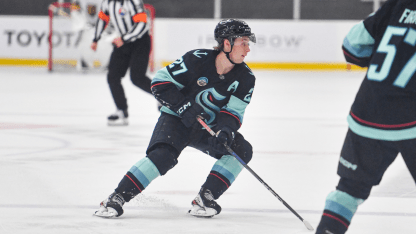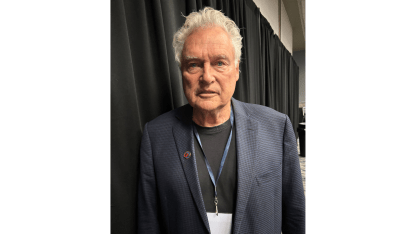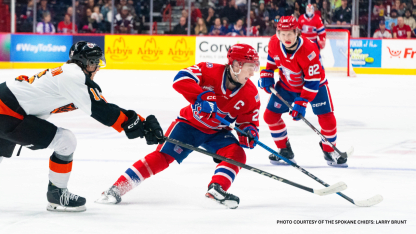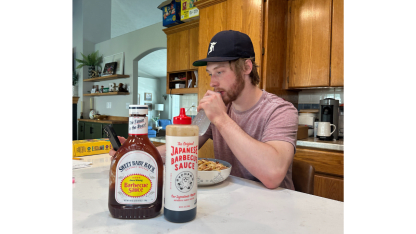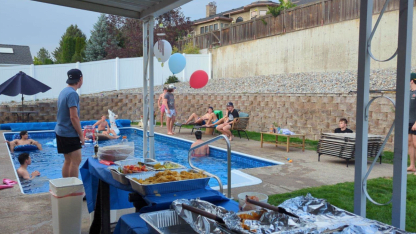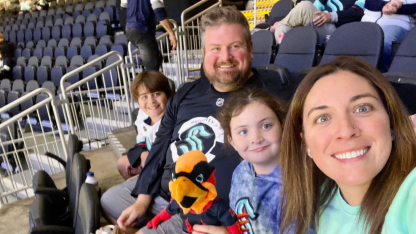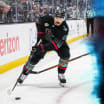He agreed his prior experiences for Team Canada internationally at U18 tournaments, Kraken camp last fall and then last winter’s World Junior Hockey Championship had likely readied him mentally to meet the moment.
“You see NHL players and how they do things and try to bring that to our program here and just elevate it,” Catton said. “I think I’ve done a good job of that this year and gotten this program to a higher level.”
Alas, a full Game 4 resurgence wasn’t to be. After a Medicine Hat goal just 31 seconds in – the third time in four series games they’d scored in the opening minute – the Chiefs replied 18 seconds later and finally gave their fans a chance to erupt into their highly popular and rather unusual Italian folk dance goal celebration.
But that was their night’s highlight, as things slipped away for good in the middle period on three Medicine Hat power-play goals.
Catton finished with a secondary assist on a power-play goal with the Chiefs down 4-1 at the time. But Catton earlier that frame, had nearly changed the game’s trajectory when, with his team down only two goals, he laid a heavy forecheck on a Tigers’ defender behind the net, stole the puck and had a point-blank chance before his shot was stopped.
It's plays such as those the Kraken will be interested in. Spokane head coach Brad Lauer, who played 323 NHL games as a winger with the New York Islanders, Chicago Blackhawks, Ottawa Senators and Pittsburgh Penguins, has worked extensively with Catton on what to do when he doesn’t have the puck.
They are both from Saskatchewan – Lauer from Humboldt and Catton from Saskatoon – so they quickly dispensed with bonding formalities when Lauer was hired last summer and got down to business.
“When I talked to him, I said I’d been fortunate to work with some pretty good players in junior,” said Lauer, previously an NHL assistant coach as well with Winnipeg, Ottawa, Tampa Bay and Anaheim. “And you know a lot of guys can play in the NHL. But a lot of guys can’t stay in the NHL.”
With regards to Catton, he was talking mainly about improving the proverbial “200-foot game” and defensive responsibilities that make his center position so challenging. But a quality forecheck out of nowhere in the offensive zone also certainly qualifies as “away from the puck” activity that can potentially swing a huge game.
Catton, who models his play after similarly built NHL forwards Jack Hughes and Clayton Keller, has strengthened his legs all season by following a regimen set out in Toronto by Kraken fitness consultant Gary Roberts. It’s helped with Catton’s above-average speed and elusiveness, his teenage frame will rely on to navigate the highly physical NHL level.
Catton had headed to the morning skate prior to Game 4 and listened to messaging from Lauer about avoiding the temptation to try to win things all on his own.
“I talked to Berkly and he’s been in some big situations,” Lauer said. “He understands the big stage and the importance of game-by-game as we go through a big tournament or series.
“I said: ‘You learned a lot in the world juniors. And some of that stuff can be used in the locker room with teammates.’ ”
But the biggest thing, Lauer added, was Catton and teammates remembering hockey is “a team game” and not to overanalyze the prior night’s Game 3 defeat.
“I don’t need anyone to be Superman,” Lauer said. “I don’t need anyone trying to be someone who they’re not.”
Thing is, Catton has often donned a cape for the Chiefs. He scored 54 goals and added 62 assists last season in almost singlehandedly willing an undermanned Chiefs team into the first playoff round.
This past season, his 38 goals and 71 assists in 11 fewer games gave him 1.9 per contest compared to last season’s 1.7. And he had winger Cristall and his WHL-leading 132 points next to him in the season’s latter half to push himself and the Chiefs to levels beyond.
“To have elite players like that, it’s kind of neat to see,” Lauer said of Catton’s elevated game alongside Cristall. “As for what he needs at the next level, he’s going to need obviously a skillset forward, a winger, a guy who can skate with him and be able to make plays with him. More of a shooter-type guy.”
That’s because Catton tends to distribute the puck often, sometimes more than his coach would like. Lauer feels Catton could stand to be more “selfish” and just fire pucks at the net.
Catton had done just that in Game 2, spurring a four-goal Spokane outburst by potting two as the Chiefs turned a 1-0 deficit into a 4-1 lead.
But selfish typically isn’t in Catton’s vocabulary.

